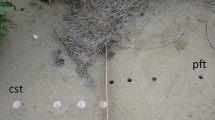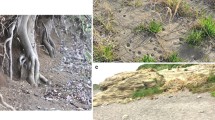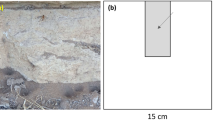Abstract
Wormlion larvae are sit-and-wait predators that construct cone-shaped pits in sandy patches to capture prey. Wormlions select microhabitats that feature favorable conditions for pit construction, in a similar way to other trap-building predators, like spiders and antlions. We investigated whether wormlions exhibit an experience-based behavioral plasticity in their pit construction behavior. In a laboratory experiment, pit sizes and relocation distances were compared between larvae that experienced either a period of unfavorable conditions, i.e., surface obstacles, shallow or coarse sand, or a period of favorable conditions, i.e., clear, deep, and fine sand and were able to construct pits undisturbed. We expected that wormlions experiencing improving conditions would build larger pits than those experiencing deteriorating conditions. In addition, we expected that larvae experiencing unfavorable conditions would be less choosy in their new microhabitat and move over shorter distances. We observed a certain effect of recent experience on the trap-building behavior; however, it was not consistent among treatments. Additionally, we detected a correlation between larval body mass, relocation distance, and pit area. These findings might suggest that past experience does not influence wormlion foraging behavior in a simple manner but that different types of experience induce different behavioral responses.




Similar content being viewed by others
References
Abràmoff MD, Magalhães PJ, Ram SJ (2004) Image processing with ImageJ. Biophotonics Int 11:36–42
Adar S, Dor R, Scharf I (2016) Habitat choice and complex decision making in a trap-building predator. Behav Ecol . doi:10.1093/beheco/arw071in press
Anderson P, Anton S (2014) Experience-based modulation of behavioural responses to plant volatiles and other sensory cues in insect herbivores. Plant Cell Environ 37:1826–1835
Barkae ED, Scharf I, Abramsky Z, Ovadia O (2012) Jack of all trades, master of all: a positive association between habitat niche breadth and foraging performance in pit-building antlion larvae. PLoS One 7:e33506
Brown JS (1988) Patch use as an indicator of habitat preference, predation risk, and competition. Behav Ecol Sociobiol 22:37–47
Carlsson MA, Anderson P, Hartlieb E, Hansson BS (1999) Experience-dependent modification of orientational response to olfactory cues in larvae of Spodoptera littoralis. J Chem Ecol 25:2445–2454
Cunningham JP, West SA (2008) How host plant variability influences the advantages to learning: a theoretical model for oviposition behaviour in Lepidoptera. J Theor Biol 251:404–410
Davis JM (2008) Patterns of variation in the influence of natal experience on habitat choice. Q Rev Biol 83:363–380
Devetak D (2008a) Substrate particle size-preference of wormlion Vermileo vermileo (Diptera: Vermileonidae) larvae and their interaction with antlions. Eur J Entomol 105:631
Devetak D (2008b) Wormlion Vermileo vermileo (L.) (Diptera: Vermileonidae) in Slovenia and Croatia. Ann Ser Hist Nat 18:283–286
Devetak D, Arnett AE (2015) Preference of antlion and wormlion larvae (Neuroptera: Myrmeleontidae; Diptera: Vermileonidae) for substrates according to substrate particle sizes. Eur J Entomol 112:500
Dor R, Rosenstein S, Scharf I (2014) Foraging behaviour of a neglected pit-building predator: the wormlion. Anim Behav 93:69–76
Farji-Brener AG (2003) Microhabitat selection by antlion larvae, Myrmeleon crudelis: effect of soil particle size on pit-trap design and prey capture. J Insect Behav 16:783–796
Guillette LM, Hollis KL, Markarian A (2009) Learning in a sedentary insect predator: antlions (Neuroptera: Myrmeleontidae) anticipate a long wait. Behav Proc 80:224–232
Hauber M (1999) Variation in pit size of antlion (Myrmeleon carolinus) larvae: the importance of pit construction. Physiol Entomol 24:37–40
Herberstein ME, Heiling AM (1999) Asymmetry in spider orb webs: a result of physical constraints? Anim Behav 58:1241–1246
Hollis KL, Cogswell H, Snyder K, Guillette LM, Nowbahari E (2011) Specialized learning in antlions (Neuroptera: Myrmeleontidae), pit-digging predators, shortens vulnerable larval stage. PLoS One 6:e17958
Ibrahim AA, Huntingford FA (1992) Experience of natural prey and feeding efficiency in three-spined sticklebacks (Gasterosteus aculeatus L). J Fish Biol 41:619–625
Jenkins BA (1994) The behavioural response of the antlion Myrmeleon pictifrons to a sudden change in prey capture rate. Acta Oecol 15:231–240
Kawecki TJ (2010) Evolutionary ecology of learning: insights from fruit flies. Popul Ecol 52:15–25
Kerr B, Feldman MW (2003) Carving the cognitive niche: optimal learning strategies in homogeneous and heterogeneous environments. J Theor Biol 220:169–188
Liang SH, Lin WY, Lin YC, Chen YC, Shieh BS (2010) Variations in the pit size of Cueta sauteri (Neuroptera: Myrmeleontidae) larvae in response to past pit-building experience and food limitation. Zool Stud 49:102–107
Liao CP, Chi KJ, Tso IM (2009) The effects of wind on trap structural and material properties of a sit-and-wait predator. Behav Ecol 20:1194–1203
Lomascolo S, Farji-Brener AG (2001) Adaptive short-term changes in pit design by antlion larvae (Myrmeleon sp.) in response to different prey conditions. Ethol Ecol Evol 13:393–397
Lubin Y, Ellner S, Kotzman M (1993) Web relocation and habitat selection in desert widow spider. Ecology:1916–1928
Morris DW (1989) Density-dependent habitat selection: testing the theory with fitness data. Evol Ecol 3:80–94
Nakata K (2007) Prey detection without successful capture affects spider’s orb-web building behaviour. Naturwissenschaften 94:853–857
Olive CW (1982) Behavioral response of a sit-and-wait predator to spatial variation in foraging gain. Ecology:912–920
Pamminger T, Scharf I, Pennings PS, Foitzik S (2011) Increased host aggression as an induced defense against slave-making ants. Behav Ecol 22:255–260
Robinson EJ, Feinerman O, Franks NR (2012) Experience, corpulence and decision making in ant foraging. J Exp Biol 215:2653–2659
Saxena KN, Schoonhoven LM (1982) Induction of orientational and feeding preferences in Manduca sexta larvae for different food sources. Entomol Exp Appl 32:173–180
Scharf I, Subach A, Ovadia O (2008) Foraging behaviour and habitat selection in pit-building antlion larvae in constant light or dark conditions. Animal Behav 76:2049–2057
Scharf I, Barkae ED, Ovadia O (2010) Response of pit-building antlions to repeated unsuccessful encounters with prey. Animal Behav 79:153–158
Scharf I, Lubin Y, Ovadia O (2011) Foraging decisions and behavioural flexibility in trap-building predators: a review. Biol Rev 86:626–639
Snell-Rood EC (2013) An overview of the evolutionary causes and consequences of behavioural plasticity. Anim Behav 85:1004–1011
Stamps JA (2006) The silver spoon effect and habitat selection by natal dispersers. Ecol Lett 9:1179–1185
Stephens DW (1993) Learning and behavioral ecology: incomplete information and environmental predictability. In: Papaj DR, Lewis AC (eds) Insect learning. Springer, NY, pp. 195–218
Tso IM, Chiang SY, Blackledge TA (2007) Does the giant wood spider Nephila pilipes respond to prey variation by altering web or silk properties? Ethology 113:324–333
Van Allen BG, Bhavsar P (2014) Natal habitat effects drive density-dependent scaling of dispersal decisions. Oikos 123:699–704
Vos M, Vet LE (2004) Geographic variation in host acceptance by an insect parasitoid: genotype versus experience. Evol Ecol Res 6:1021–1035
Werner EE, Hall DJ (1974) Optimal foraging and the size selection of prey by the bluegill sunfish (Lepomis macrochirus. Ecology:1042–1052
Wolf M, Frair J, Merrill E, Turchin P (2009) The attraction of the known: the importance of spatial familiarity in habitat selection in wapiti Cervus elaphus. Ecography 32:401–410
Acknowledgments
The research leading to these results was funded by the People Programme (Marie Curie Actions) of the European Union’s Seventh Framework Programme (FP7/2007-2013) under REA grant agreement no. [333442].
Author information
Authors and Affiliations
Corresponding author
Additional information
Communicated by: Sven Thatje
Rights and permissions
About this article
Cite this article
Adar, S., Scharf, I. & Dor, R. The effect of previous experience on trap construction and movement distance in a pit-building predator. Sci Nat 103, 83 (2016). https://doi.org/10.1007/s00114-016-1405-9
Received:
Revised:
Accepted:
Published:
DOI: https://doi.org/10.1007/s00114-016-1405-9




